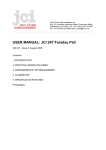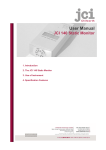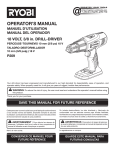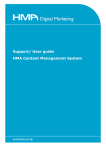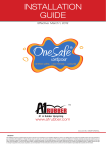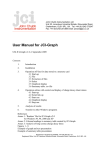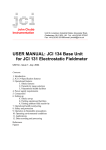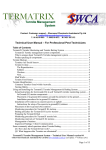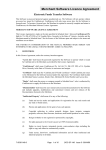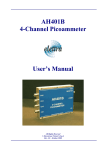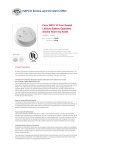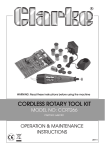Download User Manual JCI 178 Charge Measurement Unit
Transcript
User Manual JCI 178 Charge Measurement Unit 1. Introduction 2. Practical Design Features 3. Arrangements for Measurements 4. JCI 179 Discharge Probe 5. Calibration 6. Specification Features WARNING Please note that this equipment is not suitable for use where hazardous flammable atmospheres are or may be present (hazardous areas as defined in IEC 60079-10-1 and IEC 60079-10-2 inside or outside the equipment). Furthermore, even in the absence of designated hazardous areas, this equipment should not be used in close proximity to flammable substances without first conducting a risk assessment which is the responsibility of the end user company. CE Conformance Declaration of CE conformance Chilworth Technology Ltd, Beta House, Southampton Science Park, Southampton. SO16 7NS, UK declares, as designer and manufacturer of the JCI 140 Static Monitor, that the design and construction of these instruments conform to the requirements of the EC Directive on Electromagnetic Compatibility (EMC) 89/336/EEC to Standards EN 50081-1:1992 and EN 50082-1: 1992. These instruments also conform to the requirements of the Electrical Equipment (Safety) Regulations 1994 (S.I. 1994/3260). Dr Stephen Rowe, for and on behalf of Chilworth Technology Ltd. RoHS and WEEE Directives JCI Chilworth electrostatic measuring instruments are not required to conform to the RoHS Directive because they come within Category 9 exemption. To comply with the requirements of the EC WEEE (Waste Electrical & Electronic Equipment) Directive all JCI Chilworth instruments, at the end of their useful life, should be returned to Chilworth Technology Ltd for disposal or recycling in an environmentally appropriate way. Chilworth Technology Ltd is a member of the Producer Compliance Scheme ECONO-WEEE Ltd registration number WEE/KB1414VU. PRODUCT WARRANTY All test instrumentation supplied by Chilworth Technology Ltd., is manufactured to the highest specification, and as such Chilworth Technology Ltd., warrants the product against defects in materials and workmanship for a period of twelve (12) months from the date of receipt at the Customer premises, on a return to base policy. It is a necessary requirement of the warranty conditions that the instructions given in the user manual are read, understood and adhered to before putting the instrumentation into first use. If any doubt exists, please consult the manufacturer for further assistance. In such cases where the product is returned to Chilworth Technology Ltd., we will inspect the product on receipt to diagnose the fault, and will issue the Customer with an inspection and condition report. If the product proves defective during the warranty period, Chilworth Technology Ltd., at its option, will repair the product at our facilities in Southampton, UK. Provided the product has been used in accordance with the manufacturers guidelines and that the fault is due to a manufacturing defect or component failure and is not due to expected wear and tear caused by the operating environment in which it is used, this warranty covers all parts and labour, but specifically excludes any consumable parts supplied with the product and any shipping costs to Chilworth Technology Ltd. Chilworth Technology Ltd. shall not be obliged under this warranty: a) b) c) d) e) f) g) h) i) j) to repair damage resulting from attempts by personnel other than Chilworth Technology Ltd. representatives to install, repair or service the product unless directed by a Chilworth Technology Ltd. representative, to repair damage, malfunction, or degradation of performance resulting from improper use or connection to incompatible equipment or memory, to repair damage, malfunction, or degradation of performance caused by the use of non Chilworth Technology Ltd. supplies or consumables or the use of Chilworth Technology Ltd. supplies not specified for use with the product, to repair an item that has been modified or integrated with other products when the effect of such modification or integration increases the time or difficulty of servicing the product or degrades performance or reliability, to perform user maintenance or cleaning or to repair damage, malfunction, or degradation of performance resulting from failure to perform user maintenance and cleaning as prescribed in published instruction/user manual, to repair damage, malfunction, or degradation of performance resulting from use of the product in an environment not meeting the operating specifications set forth in the instruction/user manual, to repair damage, malfunction, or degradation of performance resulting from failure to properly prepare and transport the product as prescribed in published product materials to replace items that have been refilled, are used up, abused, misused, or tampered with in any way; to support software not supplied by Chilworth Technology Ltd.; to provide software or firmware updates or upgrades. In the maintenance of the product, Chilworth Technology Ltd. may use new or equivalent to new parts, assemblies or products for equal or improved quality. All defective parts, assemblies, and products become the property of Chilworth Technology Ltd. Any additional service identified and provided by Chilworth Technology Ltd. at the Customer’s request shall be invoiced to Customer at Chilworth Technology Ltd.’s current rates for parts, labour and travel. User Manual JCI 178 Charge Measurement Unit for general measurement of small quantities of charge and measurement of charge transfer in static discharges 1. Introduction The JCI 178 is a compact and easy to use instrument for the sensitive measurement of charge in the range 10pC to 200nC. The unit is shown in Figure 1. The unit incorporates a 3½ digit liquid crystal display showing directly the quantity of charge transfer measured in nano-coulombs (nC). It has an analogue output for remote display and recording of readings with opportunity for remote zeroing. For measurement of charge transfer in electrostatic discharges the unit can be fitted with a JCI 179 shielded probe. This ensures that observations can be interpreted with confidence [1,2] and valid judgements made on the risk of ignition presented in relation to quantities of charge transferred. 2. Practical Design Features The charge measurement unit has many of the same physical design features as the JCI 140 Static Monitor instrument. It is thus easy to handle, to control and to read the values from observations. The unit is based on a ‘virtual earth’ charge measurement circuit. As this ensures the input remains essentially at earth potential insulation leakage problems are minimised. Circuit design features, such as guarding, minimise zero drift and droop of readings. Two ranges of sensitivity are available. These are selected by the 3 position slide switch in the back cover of the instrument. This provides selection as: OFF/ON(20nC FSD)/ON(200nC FSD). When the instrument is operating on its most sensitive range the sensitivity can be changed to its second, lower sensitivity, range remotely by shorting pin 4 of the 8w mini-DIN to earth – yellow lead. A small push button is provided in the back cover for zeroing readings before observations. No zero setting adjustment is provided so it is necessary (and always wise) to take note of the ‘zero’ reading after the zeroing button has been released and just before charge is received. Note that with sensitive charge measurements it is desirable to hold the unit in the ‘zeroing’ state until just before measurements are made. This will reduce the chance of any zero drift. The back cover also includes a combination ‘Durable Dot’/ ‘4mm bayonet pin’ earth bonding connector, an 8w min DIN connector and a 2.1mm 12V external power supply input connection. The 8w miniature DIN connector provides for analogue output of observations, input of external power supply and opportunity for zeroing with a remote push button. The instrument must be bonded to earth for meaningful measurements. An audio alarm is included with a user settable threshold level. This may help recognition of untoward charge generation situations and identification of hazardous discharges in practical testing. 3. Arrangements for Measurement Connection to the source of charge to be measured is made via the BNC connector on the front end panel of the unit. This may be linked directly to the charge source or via a low noise coaxial cable. Care needs to be taken that no significant quantity of charge is generated by flexure or vibration of a connecting cable. The display and analogue output readings are zeroed by pressing the ‘zeroing’ push button in the rear panel of the instrument or using the appropriate connections to the 8w mini DIN connector in the back panel. Zeroing involves shorting the charge measurement feedback capacitor of the virtual earth charge sensing input circuit. At this time the input is isolated from the preamplifier. If there is some appreciable capacitance in the charge source then it may be useful to re-zero a few times to get a good low zero reading. For sensitive measurements it is best to hold the circuit in a zeroed condition until a measurement is to be made. The zero should be released a short time (a few seconds) before a measurement is made so that a good value of the zero reading and any drift is obtained from which to evaluate observations. In preparing for practical studies (for example with a Faraday Pail) it is wise to check for drift of zero and droop of finite charge readings from the system before taking measurements. 4. JCI 179 Discharge Probe Charge transfer measurements in spark type electrostatic discharges need to be made using a shielded probe such as the JCI 179[1,2]. The JCI 179 probe is a general purpose shielded probe, and this can be mounted directly on the input BNC connector of the JCI 178. The input for the virtual earth amplifier is buffered with a capacitor earth to avoid overloading the output drive capability of this amplifier. The circuits of the JCI 178 are not specially fast so they will not resolve any fast steps in the rising edge of a charge transfer but they will show correctly the overall quantity of charge transferred. Observations may usefully be recorded using a digital storage oscilloscope – for instance a Picoscope. 5. Calibration The sensitivity of charge measurement may be calibrated [3] by charging a calibrated quality capacitor to a calibrated voltage and discharging this to the instrument input. Because the input is to a virtual earth preamplifier all the charge (Q = C V) will be transferred and used as a basis for instrument calibration. For example, a 10nF 1% polystyrene capacitor charged to 1.0V is a convenient arrangement for providing 10nC of charge. (See also Calibration section on JCI Website). Since the JCI 178 used a virtual earth charge measurement circuit an alternative approach is to provide calibrated quantities of charge on the basis of switching a defined current into the output connection for a defined period of time [3]. The current is defined by a stable and known reference voltage and a precision resistor. The period of current flow is defined by selected number counting of cycles from a crystal controlled clock. The JCI 256 Charge Calibrator provides this calibration capability for quantities of charge from 1999nC with an accuracy better than 1%. Provision is included to enable the unit itself to be formally calibrated with measurements whose accuracies are traceable to National Standards. References: [1] J. N. Chubb; G. J. Butterworth “Charge transfer and current flow measurements in electrostatic discharges” J. Electrostatics 13 1982 p209 [2] J. N. Chubb “Measurement of charge transfer in electrostatic discharges” J. Electrostatics 64 2006 p321-325 (JCI Website: www.jci.co.uk/cache/ProbeStudies.pdf) [3] J N Chubb “Methods for the Calibration of Electrostatic Measuring Instruments” http://www.jci.co.uk/Calibration/Calibration.pdf 6. Specification Features Sensitivity range: Noise and Zero stability Accuracy and linearity Display: Alarm: Power supply: Controls: Connections: Dimensions: Optional extra: 20nC & 200nC FSD Noise within +10pC. Zero stable within +100pC Within +5%FSD - 3½ digit liquid crystal display of charge transfer directly in nC - LO BATT indication Pulsing audio signal when charge above user set level - PP3 replaceable battery - external isolated 12V supply – for example a JCI 142 mains unit - ON/OFF switch selecting OFF, ON 20nC & ON 200nC - Screwdriver set alarm threshold - Zeroing push button in rear cover - BNC input connector on front for charge measurement - Combination Durable Dot/4mm bayonet earth bonding connector - 8w min DIN output connector: - 2V FSD analogue signal output (5 violet) - Analogue earth (2 white) - Remote zeroing (3 red) - Remote sensitivity change (4 yellow) - External power supply inputs (8 +ve brown; 6 –ve blue) - 2.1mm d.c. input for external isolated 12V power supply 160x66x34mm Weight 300grams Shielded discharge probe (JCI 179) for measuring charge transfer in electrostatic and spark discharges Figure 1: JCI 178 Charge Measurement Unit Figure 2: JCI 178 with JCI 179 Discharge probe attached JCI Chilworth manufactures a wide range of high quality, state of the art electrostatic instrumentation. We also carry out servicing and repairs for JCI instruments, and where appropriate calibration traceable to national and international standards. JCI Chilworth is part of Chilworth Global. Chilworth Global brings together leading expert consultants in the fields of electrostatics and process safety, and GLP compliant laboratories, to provide a single point of contact for all electrostatic and process safety needs. Our laboratories provide material properties data for electrostatic problems and hazards, fire and explosion hazards (including liquids, vapours, gases and powders), chemical reaction hazards and regulatory testing. Our consultant engineers are all experienced in process safety, with individual expertise that includes electrostatics, chemical reaction hazards, and other particular aspects. Contact Information For further information on JCI Chilworth products and services visit: www.jci.co.uk email: [email protected] Chilworth Technology Ltd Beta House, Southampton Science Park Southampton, SO16 7NS, UK Tel : +44 (0)23 8076 0722 Fax : +44 (0)23 8076 7866 For Further information on Chilworth Global process safety services visit: www.chilworth.co.uk email: [email protected]









